You can see a number of actors best known for their television work in the 1960s and 1970s — Tony Randall, Barbara Eden and Arthur O’Connell — in one of the oddest films: 7 Faces of Dr. Lao.
Is it a fantasy? Without a doubt. Is it a western? I think so. Is it good? Umm … well, that’s one I’ll avoid but I’ll say this — I found it entertaining!
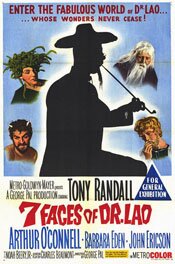 7 Faces of Dr. Lao
7 Faces of Dr. Lao
Directed by George Pal
This movie, 7 Faces of Dr. Lao, is peculiar to say the least, and in its peculiarity is a wonderful fantasy that doesn’t make for the greatest film ever made but a delightful one nonetheless.
Once seen, it’s not surprising to find it is directed by George Pal, who gave us such movies as The Time Machine. Based on a novel by Charles G. Finney titled The Circus of Dr. Lao, the movie is an odd cross between a typical western and fantasies like The Golden Voyage of Sinbad. (That movie was not directed by Pal.)
I make that comparison because you don’t often come across a western that employs old school animation. I believe it was called claymation.
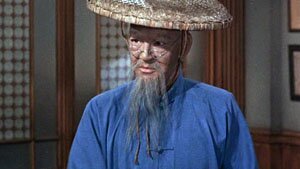 To begin with, though dressed up in western garb the movie takes its first left turn when its lead character, Dr. Lao played by Tony Randall, shows up. He is Chinese – or is he? His accent changes as the situation demands, deliberately. Dr. Lao has brought his circus to the town of Abilone (and Randall plays all the characters in the circus, including Merlin and the Abominable Snowman).
To begin with, though dressed up in western garb the movie takes its first left turn when its lead character, Dr. Lao played by Tony Randall, shows up. He is Chinese – or is he? His accent changes as the situation demands, deliberately. Dr. Lao has brought his circus to the town of Abilone (and Randall plays all the characters in the circus, including Merlin and the Abominable Snowman).
The story is relatively simple and progresses more or less episodically. Dr. Lao comes to a town and using his circus and magic and stories that teach lessons, reveals the town to itself. In doing so, he saves it from disappearing by selling out to a cynical land baron, Clint Stark played by Arthur O’Connell.
The rich and greedy man trying to buy a town to capitalize on a railroad that will soon be coming is a standard, even cliché western story. This movie would be just another, average version of that story except for its fantasy element. (The movie also has its obligatory love story as a romantic John Ericson tries to woo a resistant and bundled-up school teacher, Barbara Eden.)
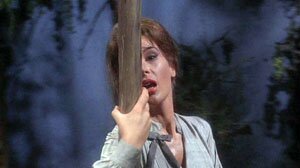 Several things make the movie stand out. The first is the unusual use of an Asian as the lead character – something unheard of for the period (1964) and especially so for a western. However, typical of the period, the Asian isn’t Asian – it’s a white Hollywood actor (Tony Randall) doing a characterization of an Asian (which, like Mickey Rooney’s Japanese man in Breakfast at Tiffany’s, probably makes the hair stand on end for anyone from an Asian country).
Several things make the movie stand out. The first is the unusual use of an Asian as the lead character – something unheard of for the period (1964) and especially so for a western. However, typical of the period, the Asian isn’t Asian – it’s a white Hollywood actor (Tony Randall) doing a characterization of an Asian (which, like Mickey Rooney’s Japanese man in Breakfast at Tiffany’s, probably makes the hair stand on end for anyone from an Asian country).
On the other hand, as it does this it also suggests that Dr. Lao might not be Asian but rather what is actually the case, a white man mimicking a western world idea of a man from China. So the movie plays it cute and cagey in this repect.
Something else that makes the movie unusual (and mentioned already) is the use of claymation. Who on earth ever heard of that in a western? One result of this is to date the movie. Seen today, the movie either has a nostalgic quality for anyone who grew up seeing these kinds of movies or, for many others, it has a retro, kitsch quality.
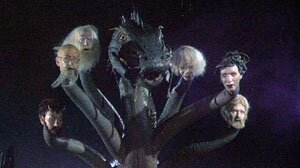 For me, the aspect I find truly interesting, and where I think this movie really veers off from its surface western look, is in how the “bad guy,” Stark, isn’t really so bad. His character is as cynical as he is because as a younger man he was so idealistic. In the end, he is happy because he has lost and thus proven wrong. And throughout the movie, he may be the nicest bad guy movies have ever seen. He’s almost always smiling.
For me, the aspect I find truly interesting, and where I think this movie really veers off from its surface western look, is in how the “bad guy,” Stark, isn’t really so bad. His character is as cynical as he is because as a younger man he was so idealistic. In the end, he is happy because he has lost and thus proven wrong. And throughout the movie, he may be the nicest bad guy movies have ever seen. He’s almost always smiling.
7 Faces of Dr. Lao is not a great movie – not by a long shot. But it is very entertaining, moves quickly, and is a more than a little fascinating for its numerous quirks. And as movies go, it’s about retro as retro gets.

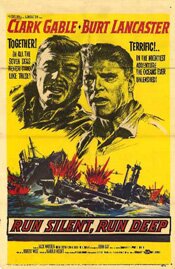 Run Silent, Run Deep (1958)
Run Silent, Run Deep (1958)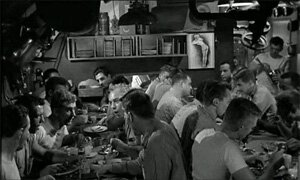 Run Silent, Run Deep is a guy movie. There are really only two female roles in the movie: a very small part as Gable’s wife (Mary LaRoche) and a pin-up poster. It’s all guys and for the most part they are confined in a submarine. Despite that, it’s a good movie. Actually, it is because of that it is a good movie. It knows what it is about and its focus doesn’t waver.
Run Silent, Run Deep is a guy movie. There are really only two female roles in the movie: a very small part as Gable’s wife (Mary LaRoche) and a pin-up poster. It’s all guys and for the most part they are confined in a submarine. Despite that, it’s a good movie. Actually, it is because of that it is a good movie. It knows what it is about and its focus doesn’t waver.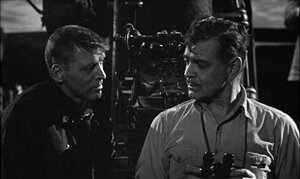 Gravitas, like the word gravity, comes from the Latin word “gravis” which means seriousness or weightiness. Gable communicates it wonderfully. Lancaster does to a degree too, though in a different way. Between the two actors, you get a nicely dramatic contrast.
Gravitas, like the word gravity, comes from the Latin word “gravis” which means seriousness or weightiness. Gable communicates it wonderfully. Lancaster does to a degree too, though in a different way. Between the two actors, you get a nicely dramatic contrast.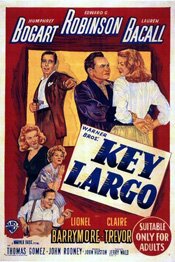 Key Largo (1948)
Key Largo (1948)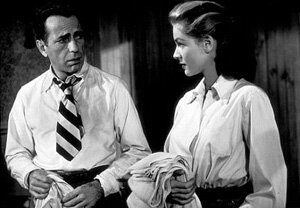 Having left the Army, ex-Major Frank McCloud goes to Key Largo to pay respects to the family of one of the soldiers under his command who was killed in action. McCloud seems a bit aimless having left the army; this obligation he feels to visit the family is about the only purpose he has at this stage in his life.
Having left the Army, ex-Major Frank McCloud goes to Key Largo to pay respects to the family of one of the soldiers under his command who was killed in action. McCloud seems a bit aimless having left the army; this obligation he feels to visit the family is about the only purpose he has at this stage in his life.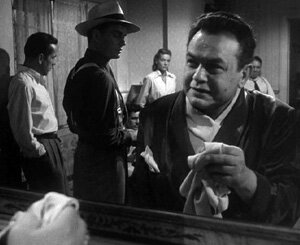 What the movie does is to bring all these characters together in one place and confine them in close quarters. You feel the walls closing in, so to speak, as the winds get stronger and shutters are closed. They are all closed in; sunlight vanishes.
What the movie does is to bring all these characters together in one place and confine them in close quarters. You feel the walls closing in, so to speak, as the winds get stronger and shutters are closed. They are all closed in; sunlight vanishes.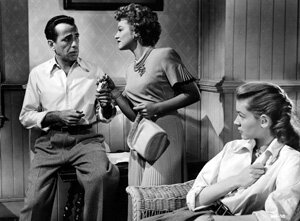 Tension builds in the movie partly because of the storm, partly because Johnny Rocco gets increasingly anxious about completing his deal, but also because of the forward and backward pull between the characters: Johnny’s will to go back to the past; McCloud and the others’ desire to break free and go forward into the future.
Tension builds in the movie partly because of the storm, partly because Johnny Rocco gets increasingly anxious about completing his deal, but also because of the forward and backward pull between the characters: Johnny’s will to go back to the past; McCloud and the others’ desire to break free and go forward into the future.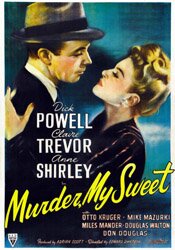 Murder, My Sweet (1944)
Murder, My Sweet (1944)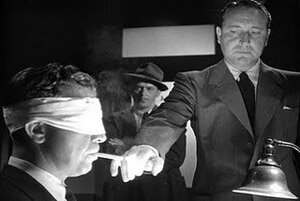 For many people Humphrey Bogart (The Big Sleep) is the Philip Marlowe. But just today I came across a review where the writer was claiming the best Marlowe was Robert Mitchum in 1975’s Farewell, My Lovely.
For many people Humphrey Bogart (The Big Sleep) is the Philip Marlowe. But just today I came across a review where the writer was claiming the best Marlowe was Robert Mitchum in 1975’s Farewell, My Lovely.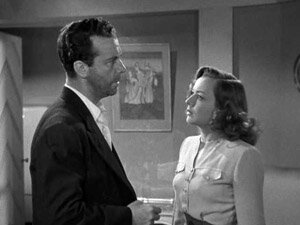 In other words, the movie twists quite a bit and in many cases the twists are arbitrary for the sake of being a twist and to sustain the mood. But they don’t make a lot of sense. Yet in a film noir, you can often get away with that because the movie is less about plot and more about atmosphere, characters, character relationships … and lighting and camera focus.
In other words, the movie twists quite a bit and in many cases the twists are arbitrary for the sake of being a twist and to sustain the mood. But they don’t make a lot of sense. Yet in a film noir, you can often get away with that because the movie is less about plot and more about atmosphere, characters, character relationships … and lighting and camera focus.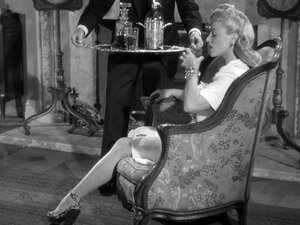 Being film noir, we also get a femme fatale. Claire Trevor is Mrs. Helen Grayle, aka Velma. Director Edward Dmytryk introduces her to us legs first, underlining the character’s sexual nature and involvement with the story. But the there is also Anne Shirley as Ann Grayle, step-daughter and enemy of the second Mrs. Grayle (Velma). It’s easy to see why.
Being film noir, we also get a femme fatale. Claire Trevor is Mrs. Helen Grayle, aka Velma. Director Edward Dmytryk introduces her to us legs first, underlining the character’s sexual nature and involvement with the story. But the there is also Anne Shirley as Ann Grayle, step-daughter and enemy of the second Mrs. Grayle (Velma). It’s easy to see why.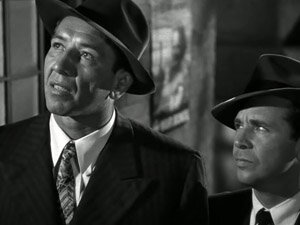 But the movie isn’t just about this. It begins with a man named Moose (Mike Mazurki), who is just out of jail and looking for his Velma.
But the movie isn’t just about this. It begins with a man named Moose (Mike Mazurki), who is just out of jail and looking for his Velma.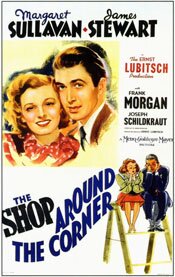 The Shop Around the Corner (1940)
The Shop Around the Corner (1940)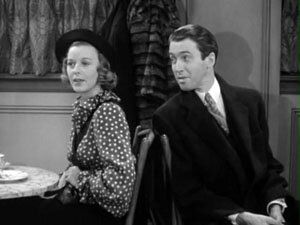 The conceit of the film is pretty simple, which may be why it is such a template for other movies: Alfred (Jimmy Stewart) and Klara (Margaret Sullavan) have begun corresponding by letter as the result of Alfred stumbling across a classified ad Klara has put in the paper for a pen-pal. Both become enamoured of the person they think they are corresponding with.
The conceit of the film is pretty simple, which may be why it is such a template for other movies: Alfred (Jimmy Stewart) and Klara (Margaret Sullavan) have begun corresponding by letter as the result of Alfred stumbling across a classified ad Klara has put in the paper for a pen-pal. Both become enamoured of the person they think they are corresponding with.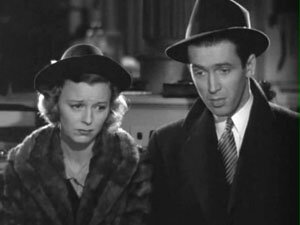 Margaret Sullavan is a terrific companion for him and the supporting cast, especially Frank Morgan (the Oz from The Wizard of Oz), are also brilliant.
Margaret Sullavan is a terrific companion for him and the supporting cast, especially Frank Morgan (the Oz from The Wizard of Oz), are also brilliant.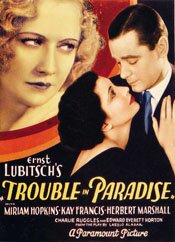 Trouble in Paradise (1932)
Trouble in Paradise (1932)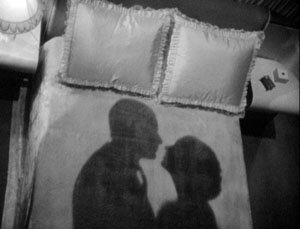 Much is made of the “
Much is made of the “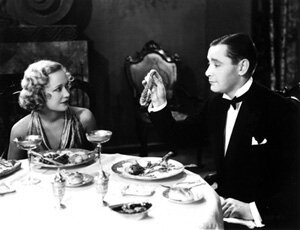 But this is what Hitchcock would call the
But this is what Hitchcock would call the 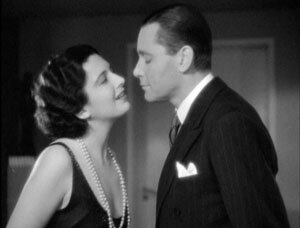 As Peter Bogdanovich mentions in his introduction to the Criterion DVD of the film, it’s a wonder this was ever made in Hollywood, particularly when we see where we are today.
As Peter Bogdanovich mentions in his introduction to the Criterion DVD of the film, it’s a wonder this was ever made in Hollywood, particularly when we see where we are today.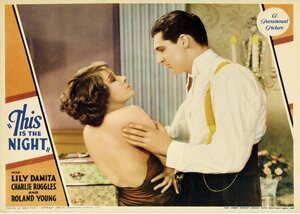 This is the Night (1932)
This is the Night (1932)
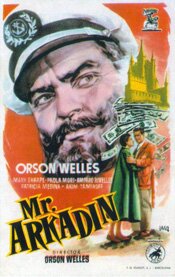 Mr. Arkadin (1955), aka Confidential Report
Mr. Arkadin (1955), aka Confidential Report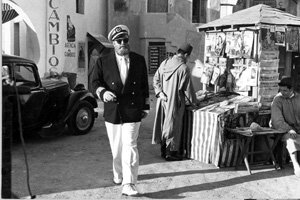 Not only do the various versions include and/or exclude various scenes, the sequence of the scenes also varies depending on the version. It was always intended to use flashbacks and a degree of disorientation for the audience, but the degree changes. The Confidential Report version may be the one that comes closest to being comprehensible, but that is open to debate.
Not only do the various versions include and/or exclude various scenes, the sequence of the scenes also varies depending on the version. It was always intended to use flashbacks and a degree of disorientation for the audience, but the degree changes. The Confidential Report version may be the one that comes closest to being comprehensible, but that is open to debate.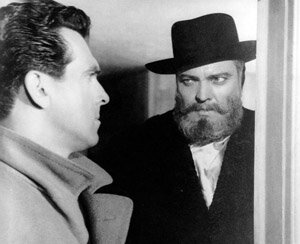 It is, however, a fascinating movie, at least if Orson Welles intrigues you. It’s hard to know just how serious Welles was in making this work. There is a high level of playfulness in the movie. Is it because he’s just having fun, mocking himself even, but not too serious about the production? Or is it an aspect of a serious film?
It is, however, a fascinating movie, at least if Orson Welles intrigues you. It’s hard to know just how serious Welles was in making this work. There is a high level of playfulness in the movie. Is it because he’s just having fun, mocking himself even, but not too serious about the production? Or is it an aspect of a serious film?
